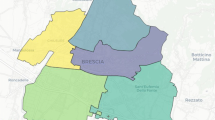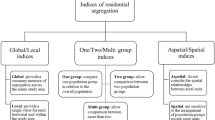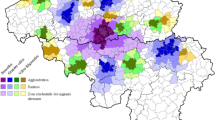Abstract
A matrix representation of places of residence and places of commuting destination in a metropolis, is coupled with evidence regarding spatio-temporal change in average household size. This approach allows the average number of persons per household who commute to be hierarchically ordered in a square matrix which shows attributes associated with a well-known class of matrices. Based on these attributes it is shown that any given spatial distribution of households implies a bounded range of vectors representing the spatial distribution of commuters. Two related distributions correspond to night-time and daytime populations in the metropolitan subareas. Whereas much of contemporary urban modelling is rooted in economic considerations, this alternative approach replaces explicit economic reasoning with some speculative considerations. The proposed methodology is applied to thirty four subareas throughout the city of Saskatoon, Saskatchewan.
Similar content being viewed by others
References
Akkerman A (1992) Fuzzy targeting of population niches in urban planning and the fractal dimension of demographic change. Urban Stud 29:1093–1114
Akkerman A (1980) On the relationship between household composition and population age distribution. Popul Stud 34:525–534
Batty M (1991) Cities as fractals: simulating growth and form. In: Crilly AJ et al (eds) Fractals and chaos. Springer, Berlin Heidelberg New York
Berman A, Plemmons RJ (1979) Nonnegative matrices in the mathematical sciences. Academic Press, New York
Burgess EW (1925) The growth of the city: an introduction to a research project. In: Park RE et al (eds) The city. University of Chicago Press, Chicago
Canada Mortgage and Housing Corporation (1991) Potential housing demand projections: Canada and the provinces 1986–2011. CMHC Research Division, Ottawa
City of Edmonton (1989) Edmonton Demographic Indicators, 1988. Planning and Development Department, Forecasting and Policy Development Group, Edmonton, Alberta
Congdon P (1991) Uses of demographic graduation in local projections. In: Local area population projections and their uses. Meeting of the British Society for Population Studies, June 1991. London School of Hygiene and Tropical Medicine, London
Dendrinos DS, Rosser JB (1992) Fundamental issues in nonlinear urban population dynamic models. Ann Reg Sci 26:135–145
Garin RA (1966) A matrix formulation of the Lowry model for intrametropolitan activity allocation. J Am Inst Planners 32:361–364
Haynes KE, Fotheringham AS (1984) Gravity and spatial interaction models. Sage, Beverly Hills, California
Hutchinson BG (1991) Metropolitan transportation: Patterns and planning. In: Bunting TE, Filion P (eds) Canadian cities in transition. Oxford University Press, Toronto, pp 263–285
Janelle DG, Goodchild M (1983) Diurnal patterns of social group distributions in a Canadian city. Econ Geography 59:403–425
Lever WF (1993) Reurbanisation — the policy implication. Urban Stud 30:267–284
Ley DF, Bourne LS (1993) Introduction: The social context and diversity of urban Canada. In: Bourne LS, Ley DF (eds) The social geography of Canadian cities. McGill-Queen's University Press, Montreal
Pooler J (1992) Spatial uncertainty and spatial dominance in interaction modelling: a theoretical perspective on spatial competition. Environ Plan A 24:995–1008
Lowry IS (1964) A model of metropolis, RM-4035-RC. Rand Corporation, Santa Monica, California
Mackett RL (1990) Comparative analysis of modelling land-use transport interaction at the micro and macro levels. Environ Planning A 22:459–475
Mills ES (1972) Urban economics. Scott, Foresman and Co., London
Odland J, Ellis M (1988) Household organization and the interregional variation of out-migration rates. Demography 25:567–579
Rees WE, Roseland M (1991) Sustainable communities: Planning for the 21st century. Plan Canada 31:15–26
Rose A (1980) Canadian housing policies. Butterworth, Toronto
Roseland M (1992) Toward sustainable communities. National Round Table on the Environment and the Economy, Ottawa
Schmid J (1988) Principles emerging from sociology for definitions and typologies of household structures. In: Keilman N, Kuijsten A, Vossen A (eds) Modelling household formation and dissolution. Clarendon Press, Oxford, pp 13–22
Schwarz K (1988) Household trends in Europe after World War II. In: Keilman N, Kuijsten A and Vossen A (eds) Modelling household formation and dissolution. Clarendon Press, Oxford, pp 67–84
Shukla V, Waddall P (1991) Firm location and land use in discrete urban space: A study of the spatial structure of Dallas-Forth Worth. Reg Sci Urban Econ 21:225–253
Simpson W (1987) Workplace location, residential location and urban commuting. Urban Stud 24:119–128
Statistics Canada (1987) Census tract (pp 132–133). Reference dictionary. Supply and Services Canada, Ottawa
Statistics Canada (1988) Profiles (Census Tracts), Saskatoon: Part 1, Table 1 (Selected characteristics for census tracts, 1986 census — 100% data). Census Canada, 1986 (Catalogue 95–153). Supply and Services Canada, Ottawa
Stouffer SA (1960) Intervening opportunities and competing migrants. J Reg Sci 1:1–20
Wilson AG (1990) Approaches to stock dynamics based on spatial interaction models (pp 45–68); Transport (pp 346–366). In: Bertuglia CS, Leonardi G, Wilson AG (eds) Urban dynamics: Designing an integrated model. Routledge, London and New York
Author information
Authors and Affiliations
Rights and permissions
About this article
Cite this article
Akkerman, A. The urban household pattern of daytime population change. Ann Reg Sci 29, 1–16 (1995). https://doi.org/10.1007/BF01580360
Received:
Accepted:
Issue Date:
DOI: https://doi.org/10.1007/BF01580360




